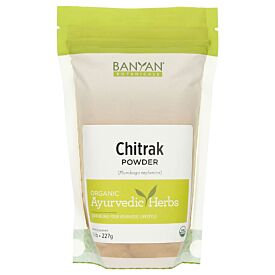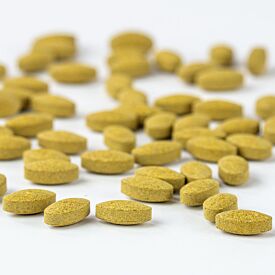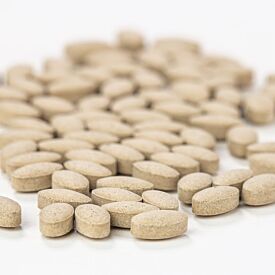Chitrak: Getting to Know Your Herbal Allies
Okay, raise your hand if you’re familiar with chitrak. Anyone? This herb isn’t one that tends to elicit much enthused press coverage, compared to some of our other Ayurvedic herbal stars. But don’t let this fool you—chitrak has withstood the test of time in the Ayurvedic pharmacopoeia for good reason and can be quite the powerful ally.
With its delicate white flowers and beautiful green foliage, chitrak, or Plumbago zeylanica, may seem gentle—almost fragile—in nature. It calls to mind sweet flower gardens (which, by the way, is where it and many of its cousins can be found). Its unassuming appearance hides a much different personality, however, as there is nothing gentle or fragile about chitrak’s herbal strength. In fact, we would go so far as to say chitrak has a pretty fiery attitude. Attitude?!—yup, that’s right.
This attitude is captured in many of its names. Chitrak is Sanskrit for “spotted one,” which is a nod toward its namesake, the spotted leopard, alluding to its powers to speedily chase down and destroy its prey. It is also known as agni, meaning fire, or jvala, meaning flame. This herb is no joke: chitrak is HOT, and a little goes a long way. Chitrak brings fire into your body, drying out kapha, warming up vata, and “revving” up your digestive fire. To help illustrate this, picture a damp, struggling campfire—throw a little chitrak on the weak flame, and it will act like starter fluid, awakening a cheerfully crackling fire that can help remove damp and cold. And the heating effects of chitrak are not limited to the digestive system. For example, chitrak is even known to dry out excess kapha in the lungs.1 That’s one powerful herb!
Chitrak is so heating and potent that just touching the leaves and stems can irritate the skin and cause a red, inflamed, itchy rash! This explains why the Spanish called it malacra—bad face—and erva de diablo—devil’s herb. Some practitioners actually use this irritating quality for therapeutic purposes, but we don't suggest trying it at home or without the guidance of a professional.2
Let’s go back to discussing your digestive fire. Keeping a well-stoked digestive fire causes a great chain reaction throughout your body: the stronger your digestion is, the easier your body can process food and assimilate the nutrients. This consequently helps support optimal weight and a happy, healthy liver, and it helps your body digest fat. Have some built-up ama? Chitrak can help with that too. After all, Ayurveda recognizes that health begins in the digestive system. If you support your digestion and tend to your agni, you’re on the right track for spreading balance throughout your entire body.

Agni, jvala, erva de diablo, the spotted one—these names demand respect. Just as you wouldn’t want to flippantly play with fire—or with a spotted leopard—you wouldn’t want to thoughtlessly mess around with this herb. After all, a lot of a good thing isn’t always better. Think again of that campfire: if you throw too much starter fluid on the fire, it can cause a wildfire, increasing your fire to the point at which damage can occur.3
Thankfully, Ayurveda gives us the tools to successfully use chitrak. Namely, use it with other herbal buddies. Like any good friend, these herbal buddies stand in and help chitrak’s strengths shine while keeping that attitude in check. Healthy Kapha tablets, Trim Support tablets, and Trim Balm all harness chitrak’s fiery personality while balancing out its harsher qualities with the presence of the other herbs. In these formulas, chitrak helps increase agni, which in turn aids in digesting ama. Kapha Massage Oil uses chitrak to help warm and revitalize kapha. Chitrak is also included in two traditional Ayurvedic guggulu formulas: in Yogaraj Guggulu, chitrak helps remove ama from the joints and muscles. In Punarnavadi Guggulu, chitrak not only helps to remove ama but also helps burn up excess kapha that manifests in the form of excess fluids.
If you’re looking to use chitrak as a powder, Ayurveda offers some suggestions. For example, if you have excess kapha accumulating in your lungs, mixing licorice, pippali, and ginger with chitrak can help dry out that kapha. Lime juice and chitrak are commonly combined as the lime helps mellow chitrak’s heat. Looking for rejuvenation? Ghee and chitrak are a traditional and potent combination.4
Please note that this hot-natured herb isn’t recommended during pregnancy nor if you’re experiencing high pitta.
Respect it. Love it. Remember it needs buddies to stay in line. If you do that, chitrak will give you heroic support, from fueling your digestive fire to aiding in healthy weight management, from destroying ama to revitalizing kapha—and so much more.












